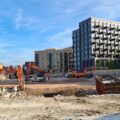There was some cheer to be had out of another interest rate cut from the Bank of England last week but if policy makers think this will kick start the development market then I fear disappointment is ahead. The Home Builder’s Federation, always well timed in its actions, put out their quarterly Housing Pipeline report identifying sites approved between July and September marked the lowest quarterly outturn since the HBF began reporting in 2006. Ouch.
According to their analysis, planning approvals will need to increase by more than 150% to meet the Government’s target of 370,000 homes annually. Given the planning system is more than creaking through resource constraints, it’s really difficult to see how the system as currently conceived could handle such an uptick. Just like there are not enough brickies, there are also not enough planners to administer the workload.
Speaking of brickies, the CPA identified brick deliveries in 2024 were marginally higher (2.2%) than in 2023. That’s good news – but it came in under the 4-6% the CPA was predicting and is still 27.6% lower than in 2022. Meanwhile private housebuilding registrations rose 11% from last year according to the NHBC. This is partly due to builders trying to start before the new building regs kick in and represents a long tail of consents getting underway as regulatory regimes change. The tank is emptying out.
The raft of planning reforms coming through alongside hopefully continued interest rate cuts will do something to stimulate new home building. It will take time to bed in, a lot of time.
The 1.5 million homes target looks likely to be missed by some margin. The Government is missing a trick. None of the current planning reforms really address the logjam of planning consents which are stuck because of viability changes as a consequence of the pandemic and the regulatory changes due to building safety.
After the last great crash, the Government brought in Section 106 BA to help developers to apply to modify or discharge affordable housing obligations in a S106 agreement that made their development economically unviable. This should be brought back. It’s administratively neat as the consents are already there. It’s something which the Government could offer to reflect the consequences of the second stairwell fiasco and the new building safety regime. Many consents are stuck mid stream. Interventions which address the various stages of the development cycle will be more meaningful then just the start.








